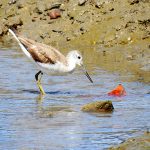COMMON GREENSHANK
The Common Greenshank is a sleek, long-legged wader from the sandpiper family. It is distinguished by its greyish-green legs and a slightly upturned, delicate bill. Adults typically display a grey back and white underparts during the non-breeding season, which transforms into a more pronounced pattern with darker, barred feathers during the breeding season. These birds are known to live up to about 10 years in the wild, navigating through various challenges of nature and migration.
During the breeding season, which begins around April or May, the Common Greenshank performs captivating aerial displays accompanied by loud, ringing calls that resonate across their otherwise quiet habitats. These birds adopts a solitary nesting strategy. The nests are usually simple depressions on the ground, lined with vegetation, and are often located in the taiga and tundra of northern Europe and Asia. The solitude of their breeding grounds contrasts with their more sociable behaviour outside this season. A typical clutch consists of 3-4 eggs, which both parents protect and incubate. The chicks are precocial, meaning they are relatively mature and mobile from the moment of hatching.
The Greenshank is a true globetrotter. While they breed in the northern reaches of Europe and Asia, their wintering grounds are impressively distant, stretching all the way to Africa, southern Asia, and Australia. During their migration, they frequent estuaries, wetlands, and mudflats, where they can be seen gracefully wading in shallow waters. This species is part of the East Asian-Australasian Flyway, one of the most remarkable migration routes that spans several continents and covers thousands of kilometers.
The Common Greenshank is opportunistic and versatile. It primarily feeds on insects, small fish, crustaceans, and various small invertebrates. It hunts in classic wader fashion, wading through shallow waters, swiftly picking out prey with its sensitive bill. Due to their dependence on wetlands, Greenshanks are considered important indicators of the health of these ecosystems. Changes in their population can signal changes in the quality of the environment.
While currently listed as Least Concern by the IUCN, the Common Greenshank’s welfare is tightly linked to the conservation of wetlands across its migratory and breeding range. The degradation of these habitats due to drainage, pollution, and development poses a significant threat to their populations. Protecting these environments not only benefits the Greenshank but countless other species that share these habitats.
The Common Greenshank, with its graceful demeanor and extensive travels, serves as a reminder of the interconnectedness of global ecosystems and the shared responsibility to protect them. Every sighting of this remarkable bird is a testament to the resilience of nature and the importance of global conservation efforts.






